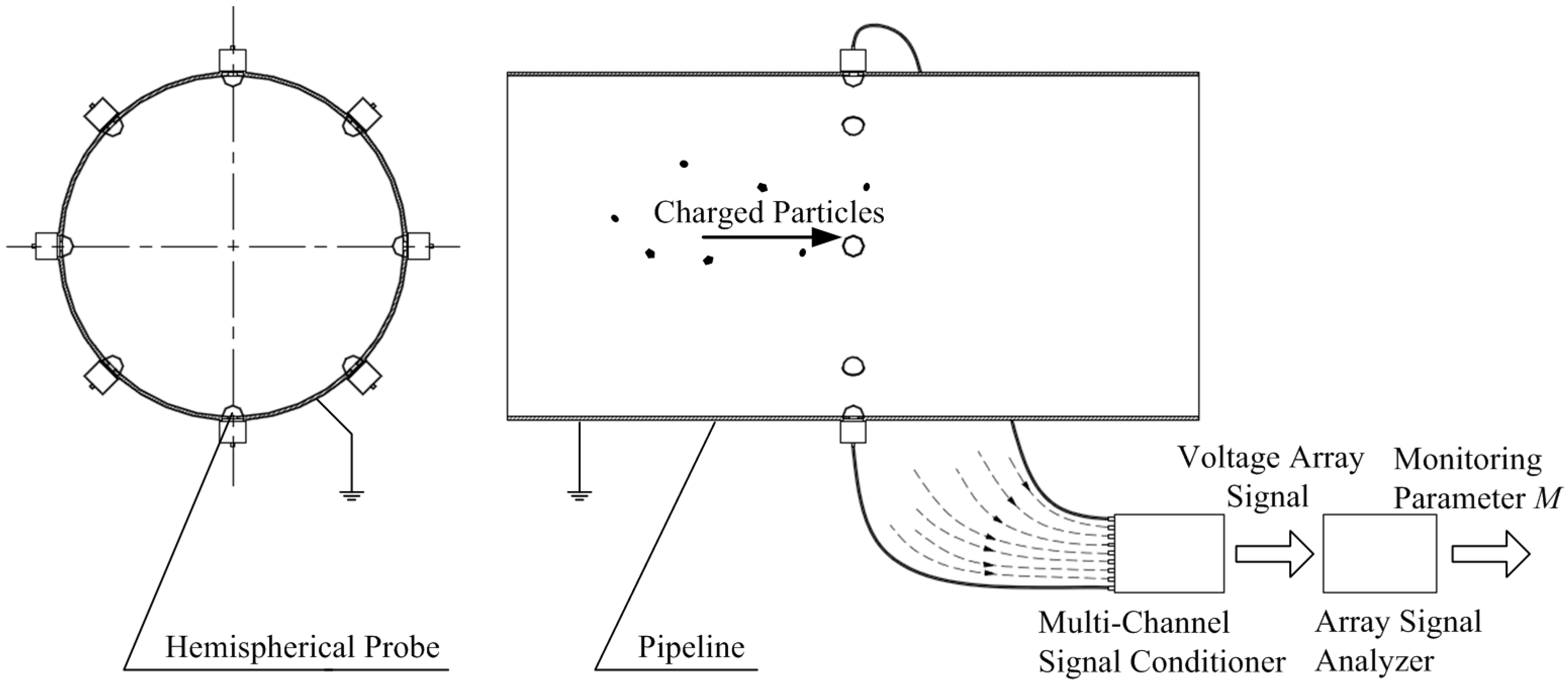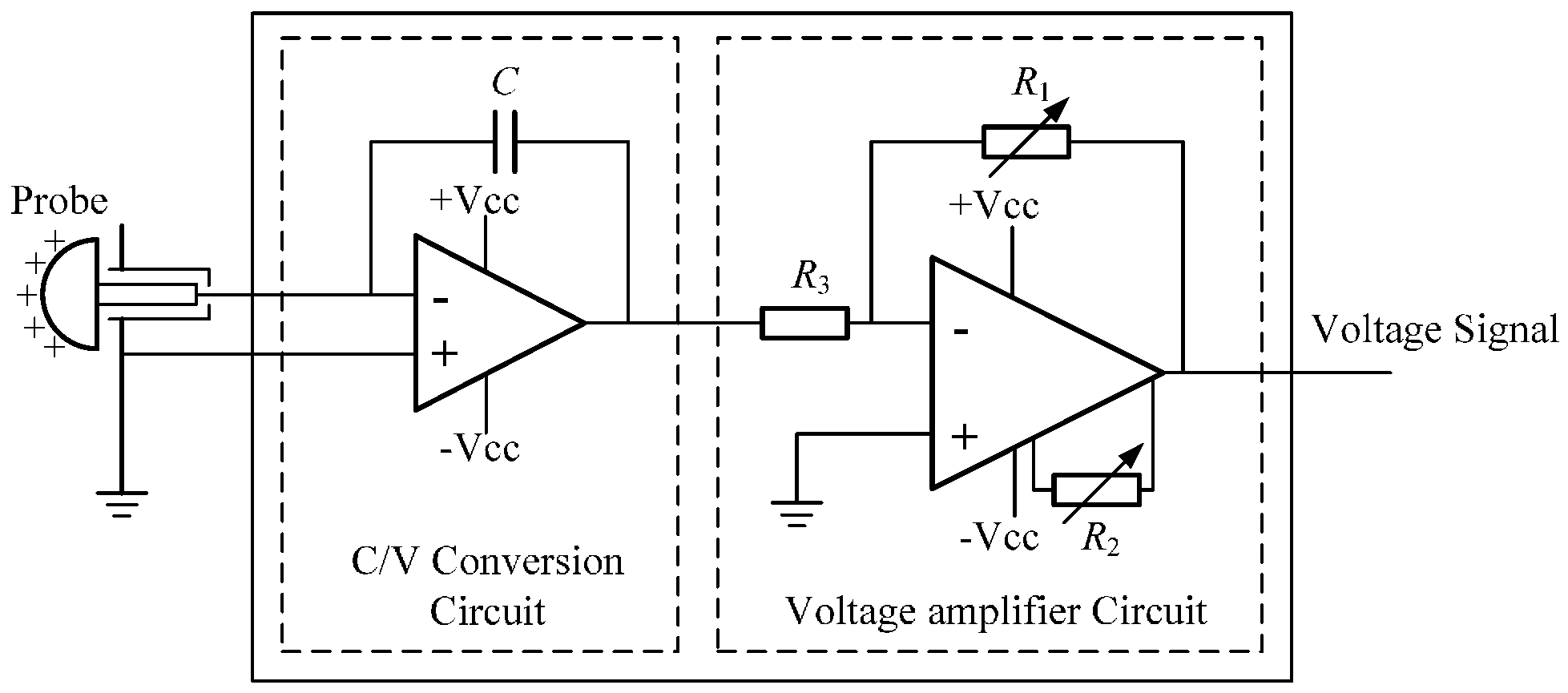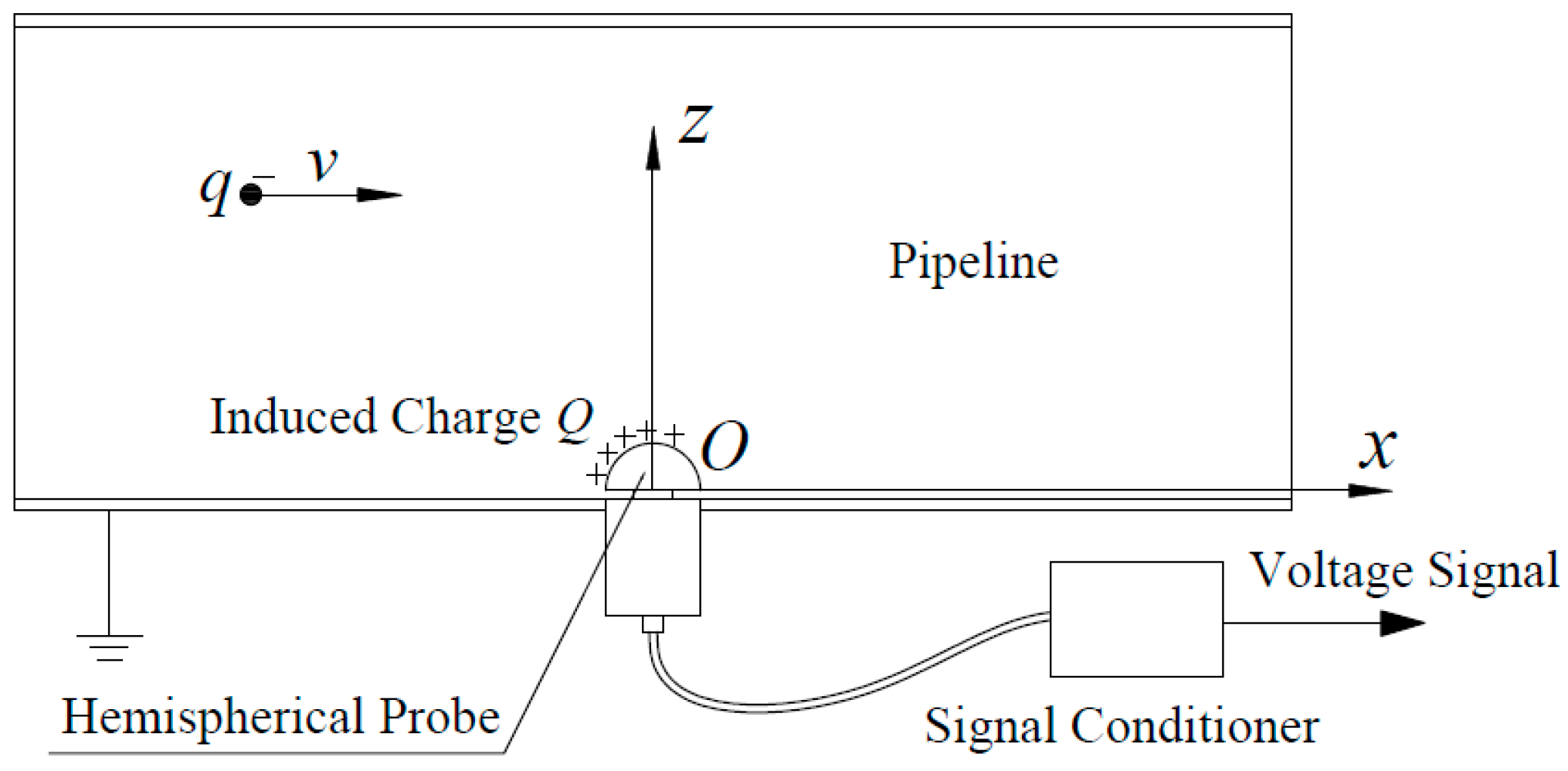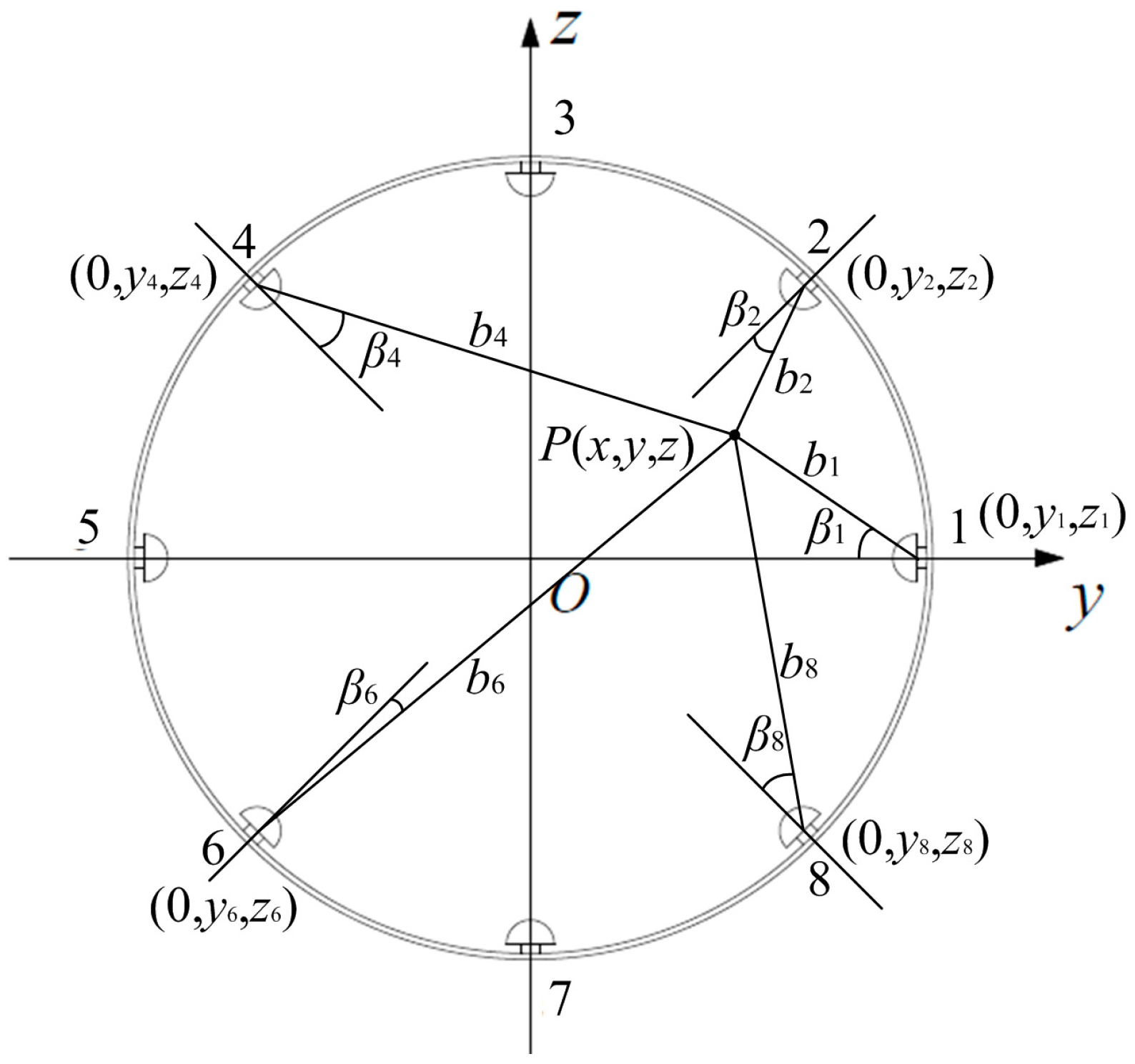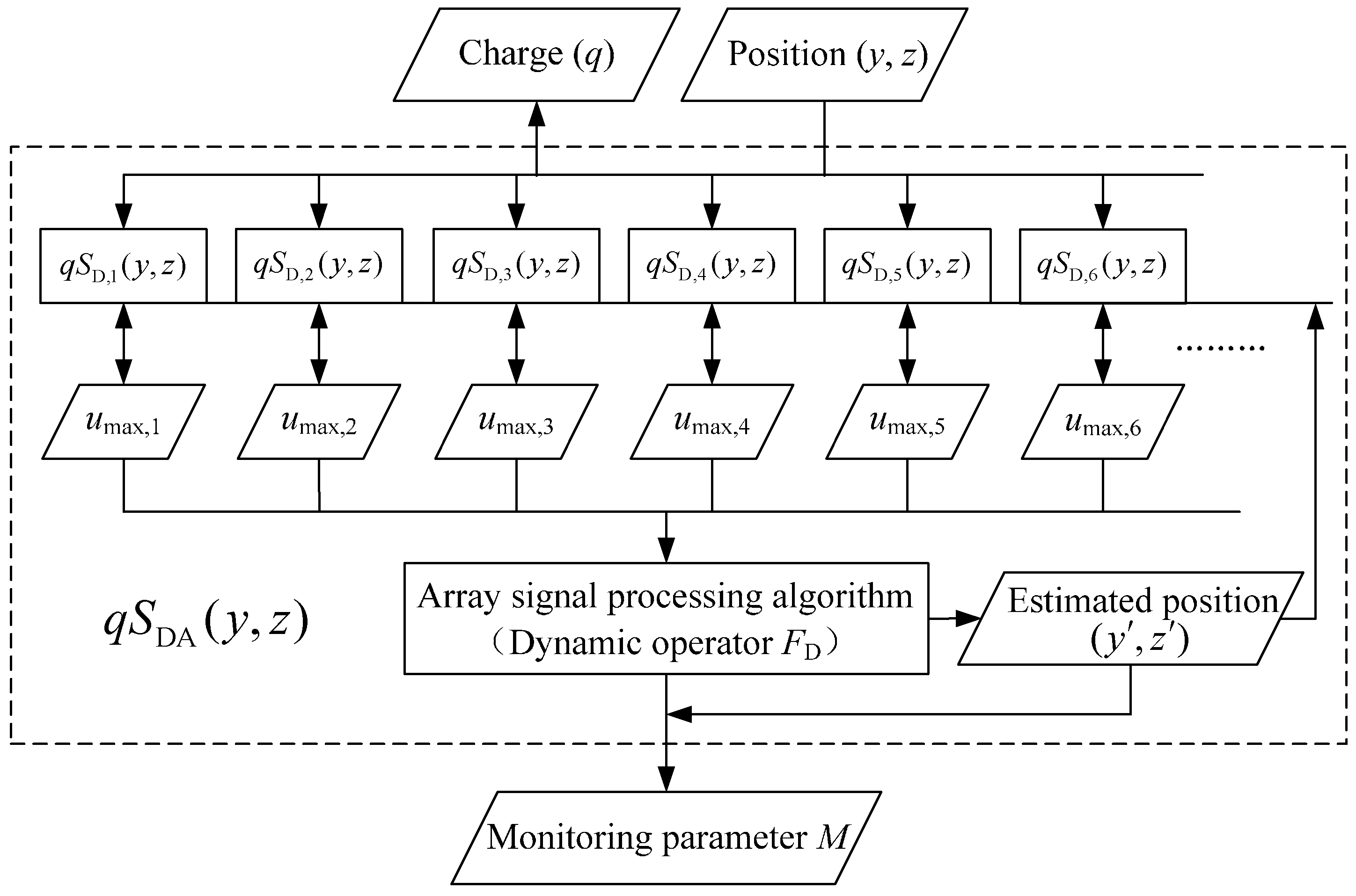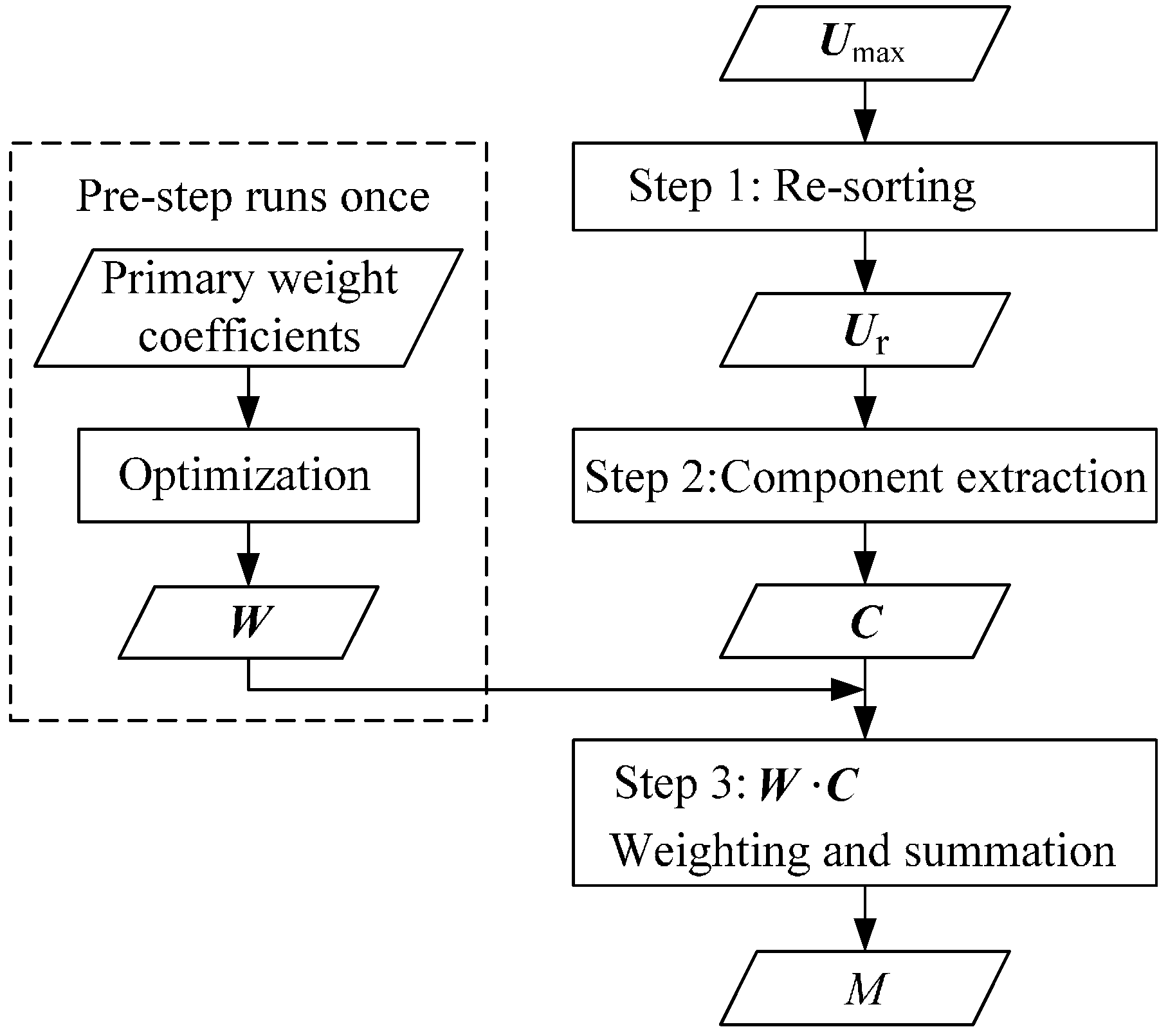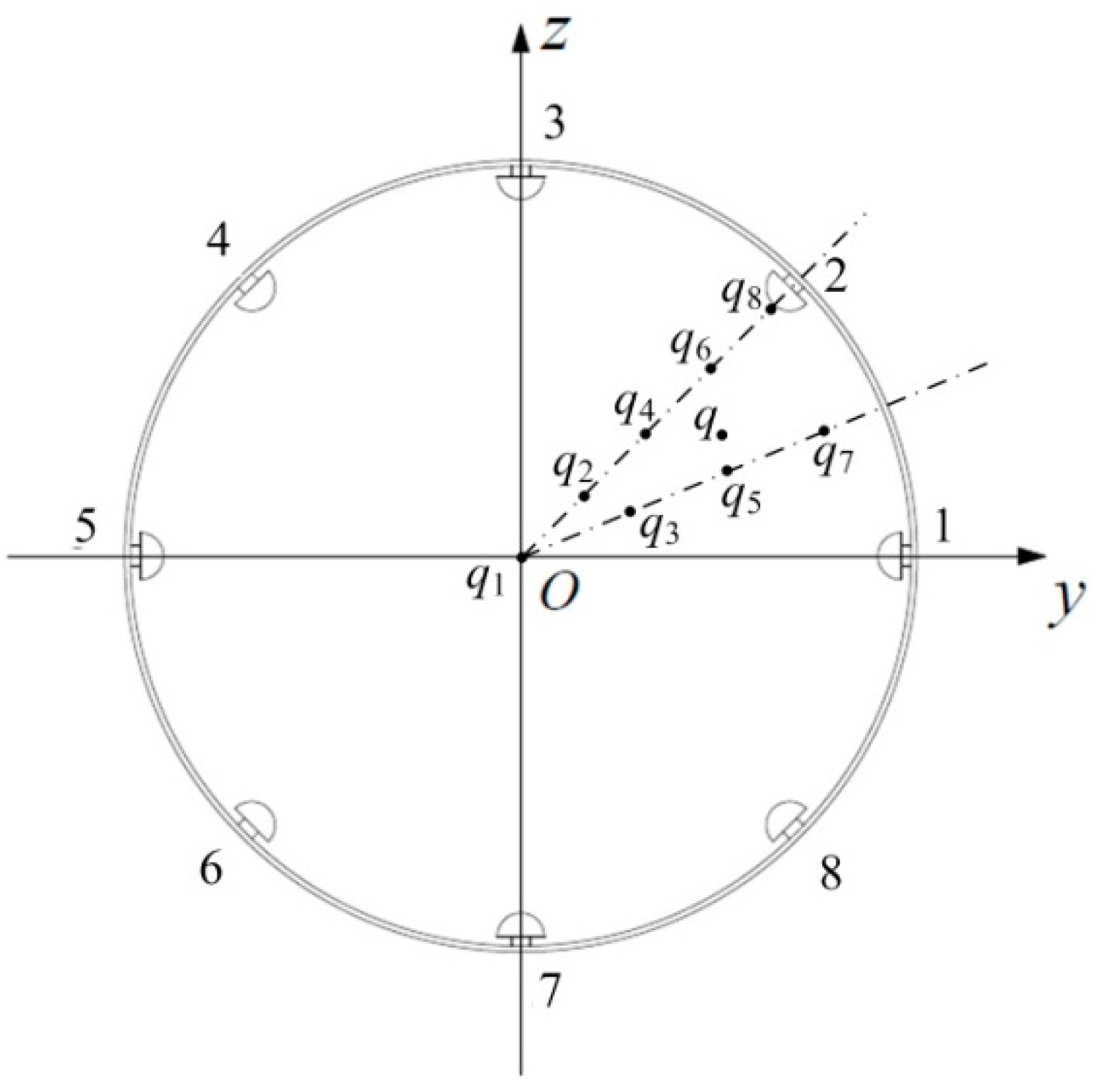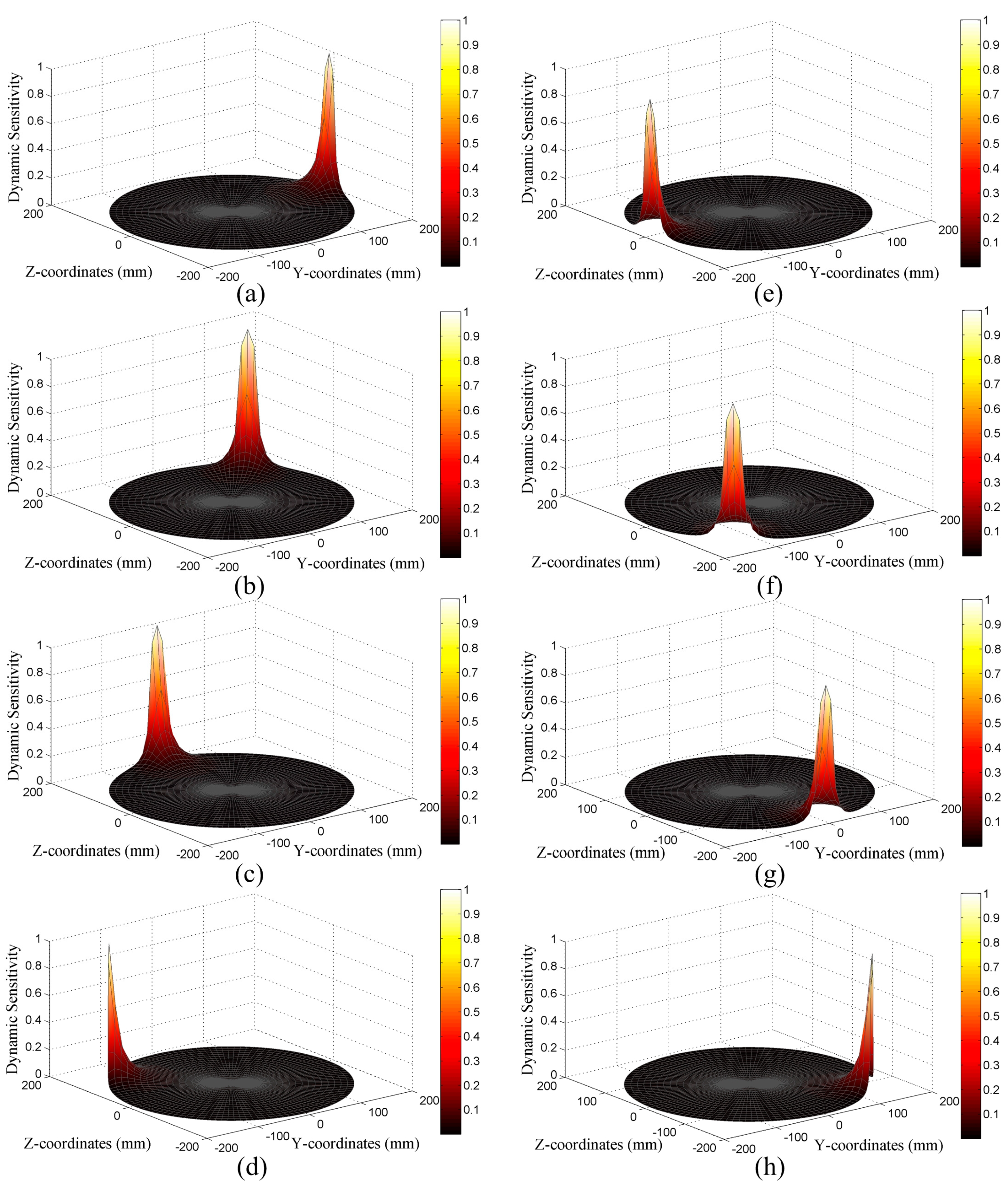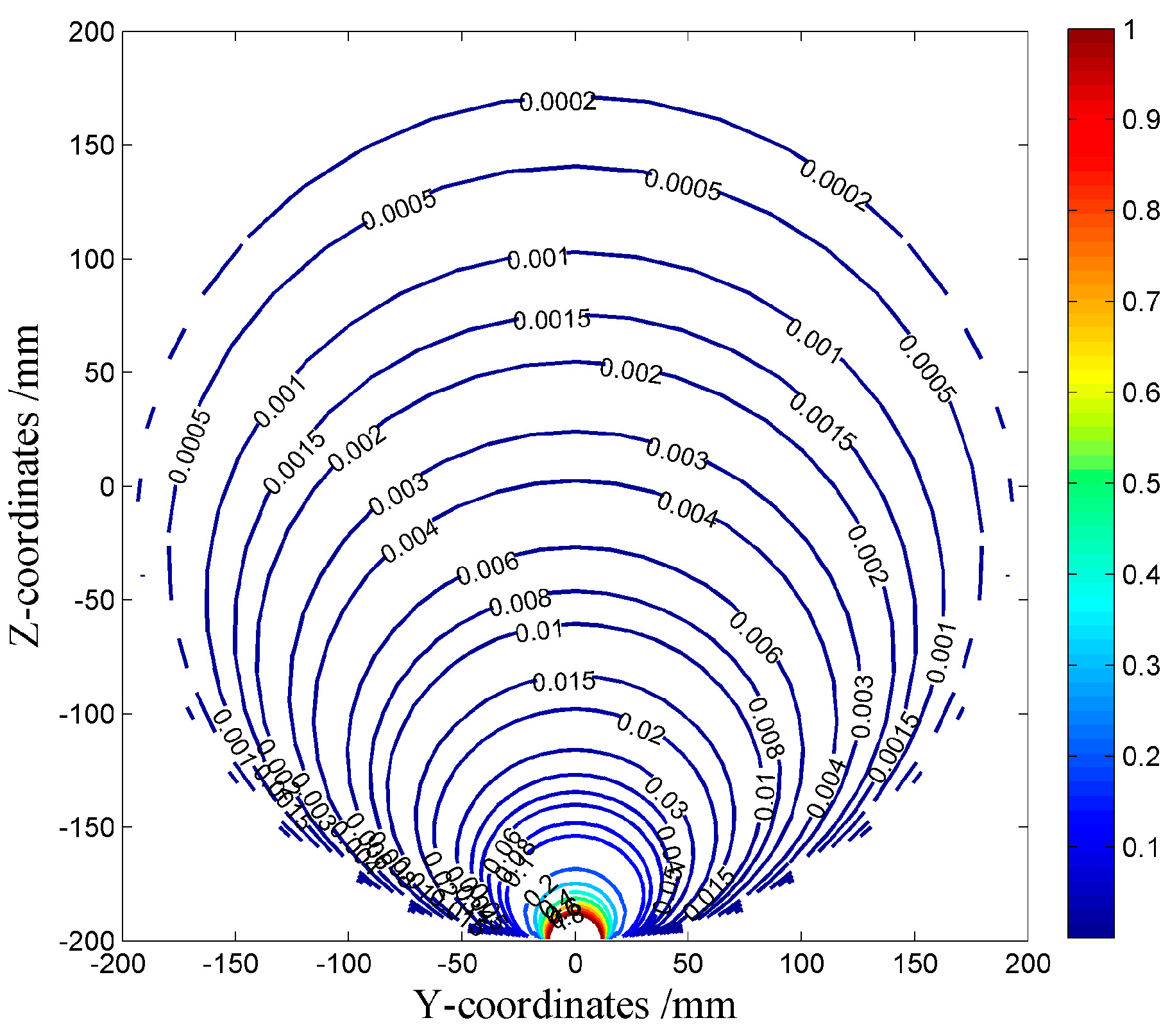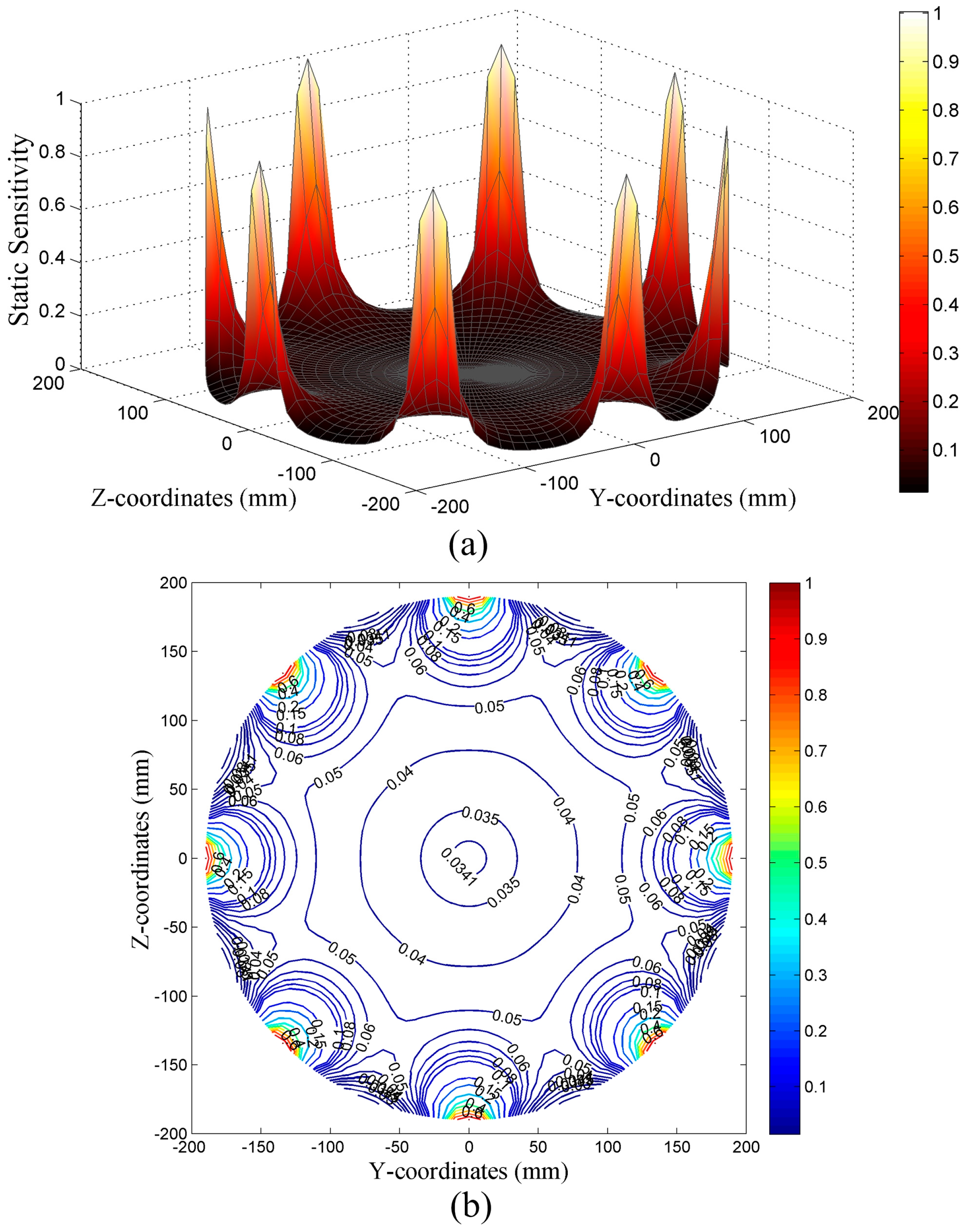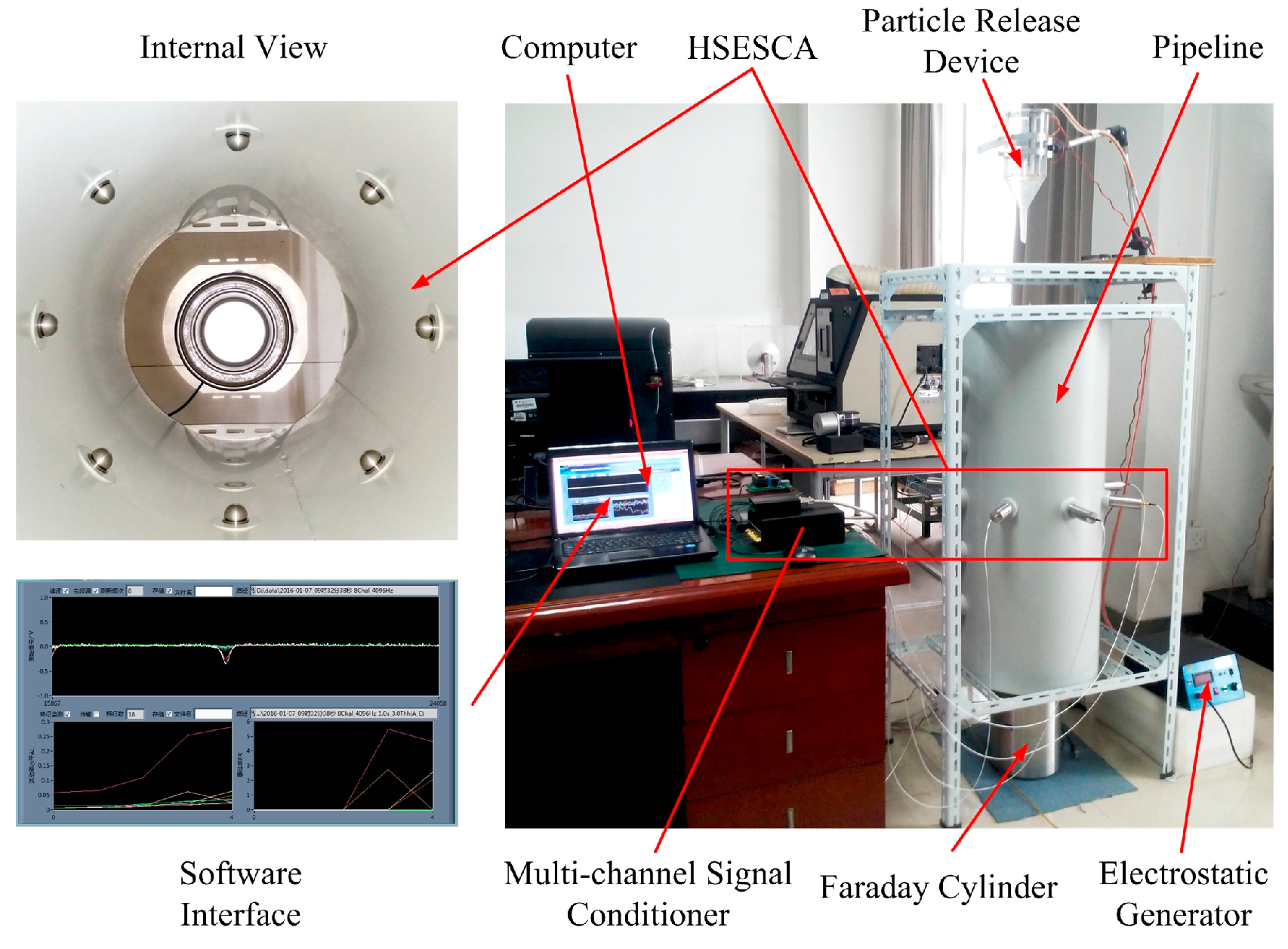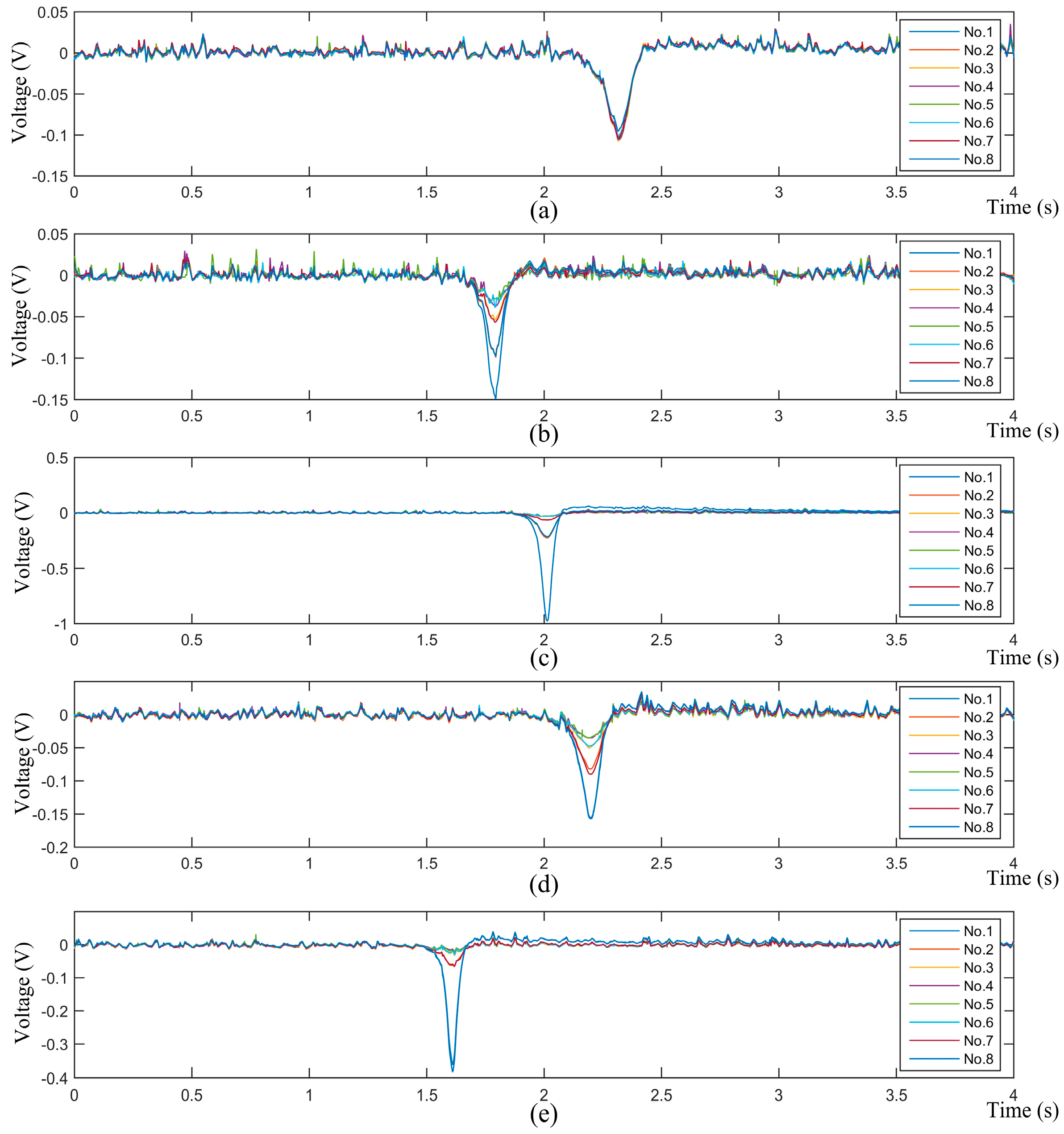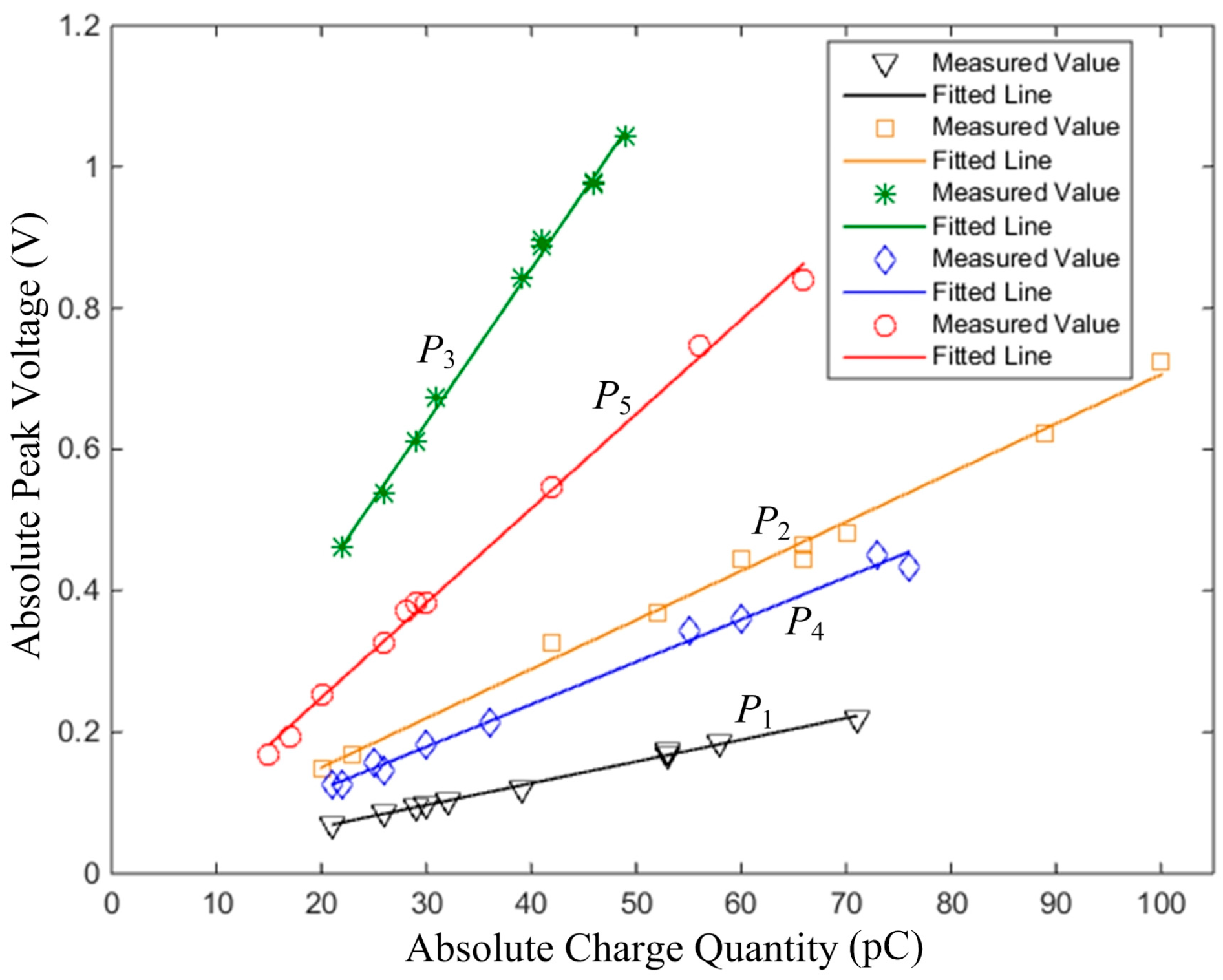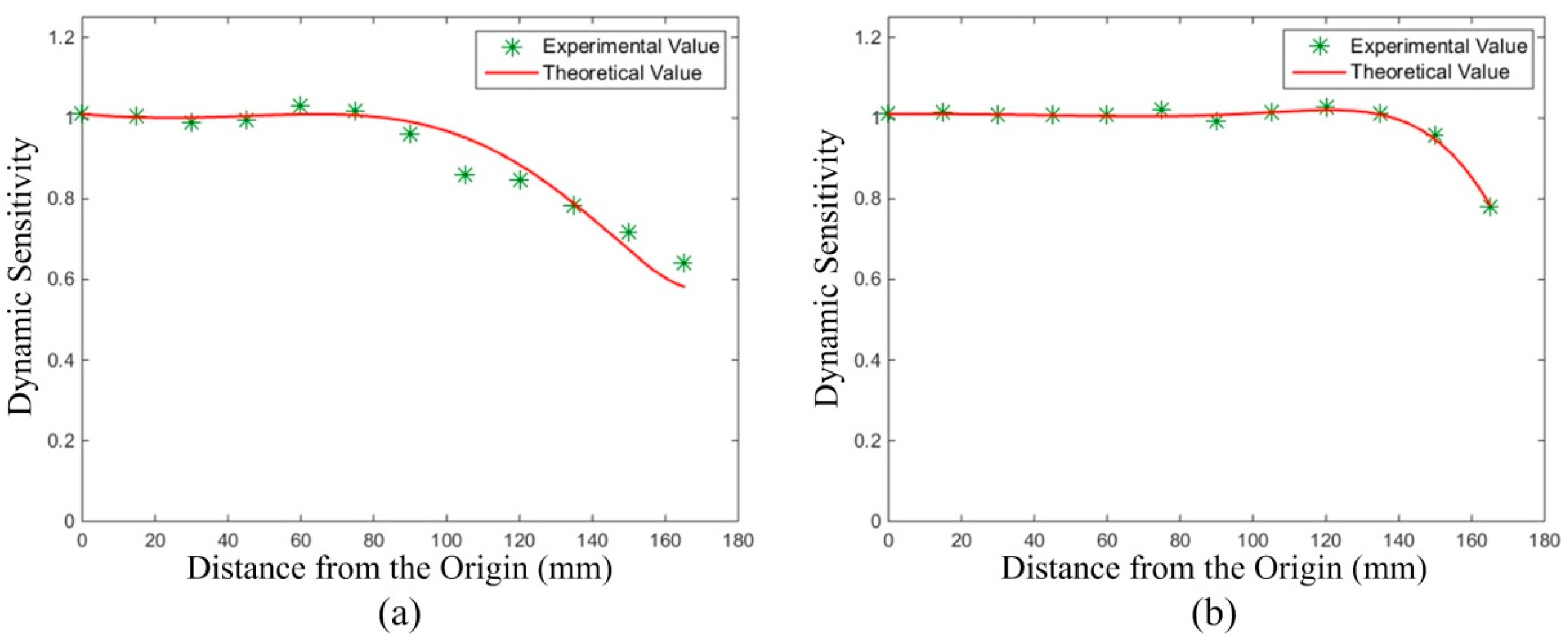1. Introduction
Electrostatic monitoring systems (EMSs) are featured with the advantages of robustness and low cost [
1,
2], making them very promising in parameter monitoring of gas-solid flows [
3,
4,
5], exhaust debris monitoring-based PHM of gas turbines [
1,
6,
7], etc. Electrostatic sensors are key components of EMSs. Among them, hemisphere-shaped electrostatic sensors were proposed by us as a trade-off between intrusive and non-intrusive electrostatic sensors. They combine the advantages of relatively high sensitivity, easy installation, flexible layout, accuracy in theoretical modeling and cause very little disturbance to flows [
8,
9].
The sensing principle of an electrostatic sensor is electrostatic induction. It determines that even if a particle carries a constant charge, the corresponding induced charge on an electrostatic sensor probe will reduce sharply when the distance between the particle and the probe gets larger. As a result, a near particle with quite weak charge can generate similar signals as a far particle with great charge. That is to say, the charge quantity of a particle can hardly be accurately monitored by a single electrostatic sensor if the position of the particle is not provided. In view of the sensitivity, this means that most electrostatic sensors have the drawback of inhomogeneous and quite localized sensitivity; thus, only particles near the probe can be effectively detected [
8,
10]. In a word, as for the applications that need the accurate particle charge (e.g., particle size monitoring or gas-solid flow density monitoring), an EMS that contains a single electrostatic sensor is usually of poor monitoring accuracy. Moreover, a total failure of the whole system will occur if only the sensor breaks down. Therefore, in order to obtain better monitoring accuracy and reliability, EMSs composed of multiple electrostatic sensors have become the trend [
5,
11,
12]. They are usually called electrostatic sensor arrays (ESAs), and the electrostatic sensors are called the sensor unit. Two aspects are of high concern in relevant research: the first is the hardware design and related sensing characteristics analysis; the second is the application and related array signal processing algorithms.
Circular ESA is a kind of representative hardware structure, which is made up by placing some identical electrostatic sensors uniformly around a circular pipeline in one cross-section [
12,
13,
14,
15,
16,
17,
18]. Xu et al. used arc-sharped electrostatic sensors to construct circular ESAs and used the finite element method to study the sensing characteristics of the sensor units. Some geometric and material influence factors on the sensing characteristics were also analyzed [
18]. Thuku et al. studied circular ESAs composed of rod-shaped electrostatic sensors [
5,
19]. A sensing model of the sensor units was built, and a comparison between four and 16 sensor systems was made [
17]. In addition, differently-sized circularplate-shaped and rectangular plate-shaped electrostatic sensors were modeled and analyzed [
20]; they are also suitable for circular ESAs. However, existing works on the sensing characteristics were generally focused on individual electrostatic sensors, thus lacking descriptions and models for the sensing characteristics of a whole ESA. In addition, as a fundamental and the most commonly-used sensing characteristic, sensitivity should reflect the monitoring accuracy of an EMS directly. As for an ESA, this means that a proper sensitivity definition should build a direct relationship between the monitored particles and the monitoring parameters of the whole ESA. However, the usually used spatial sensitivity only builds a basic relationship between static charged particles and corresponding induced charge on a sensor probe [
10,
18,
21]; thus, it is called static sensitivity here. In practice, particles to be monitored are always moving. Furthermore, as a three-dimensionally-defined parameter, static sensitivity is difficult to accurately model when real boundary conditions are considered [
9]. More importantly, follow-up processing of the induced charge is not considered in the definition, such as charge-voltage transformation and array signal processing algorithms. In a word, in order to build a direct relationship between the monitored particles and the monitoring parameters of a whole ESA, thus reflecting its monitoring accuracy directly, a more practical sensitivity definition needs to be defined in a systemic perspective.
In the aspect of application, a circular ESA is usually used to detect the particle distribution over the cross-section of a pipeline and further infer gas-solid flow parameters, such as particle density and flow regime. In these cases, the particles to be monitored are continuous in the time domain. That is to say, there are always numerous particles passing a cross-section simultaneously, thus forming an obvious profile of the solid-phase, which can be imaged by tomography-based methods [
5,
11,
14]. ESAs with arc-shaped sensor units usually adopt array signal processing algorithms based on electrical capacitance tomography [
11,
12,
16,
22,
23]. They are suitable for dense gas-solid flows. There are also reports on volume tomography using multi-circular ESAs with arc-shaped sensor units [
24,
25,
26]. ESAs with rod-shaped sensor units usually adopt algorithms based on electrostatic tomography [
5,
14,
18]. They are suitable for both dense and dilute gas-solid flows. However, because of the limited number of sensor units, the tomography-based algorithms are faced with tough ill-conditioned problems, which lead to poor image resolution [
11,
16]. Improvements can be made by increasing the unit number [
17] and adopting some iterative regularization methods, filtering methods, error minimization protocols, etc., which will increase the computation time [
11,
12,
16]. As a result, the tomography-based algorithms only indicate approximate areas where particles concentrate, but they cannot accurately confirm where discrete particles are located. Moreover, the algorithms are more suitable for relatively stable flows, because the monitoring accuracy can be improved by making a compromise on the computation time. In contrast, particles to be monitored could be quite intermittent in some applications. That is to say, there are only one or just a few particles passing a cross-section simultaneously. One representative application is exhaust debris monitoring-based PHM of gas turbines [
7,
17,
18,
19,
20,
21,
22,
23,
24,
25,
26,
27,
28,
29]. In this case, the occurrences of fault-related particles are accidental and instantaneous. In other words, first, the particles to be monitored are quite intermittent. Second, a fast array signal processing algorithm is needed to avoid missing the fast-passing particles. Besides, the size and charge quantity of the particles, rather than the distribution, are concerned. A measurement technique was studied by Addabbo et al. to estimate the trajectory position, charge and velocity of a moving charged particle. It was based on a small array whose electrostatic sensors have improved low-frequency response [
30,
31]. However, relevant studies are scarce yet. As for a circular ESA, array signal processing algorithms remain to be designed for the intermittent particle monitoring.
To solve the problems above, the dynamic sensitivity of ESA is proposed to describe the sensitivity of ESAs in a systemic perspective. An ESA called the hemisphere-shaped electrostatic sensors’ circular array (HSESCA) along with its application in intermittent particle monitoring are taken as an example. In detail, a sensing model of the HSESCA, as well as that of the sensor units is built in
Section 2. On this basis, array signals of the HSESCA are analyzed, and the dynamic sensitivity of ESA is thereupon defined in
Section 3. A component extraction-based array signal processing algorithm for discrete particle monitoring is designed in
Section 4. Numerical simulations and experiments are done for validations in
Section 5. The main results are concluded in
Section 6.
3. Definition of the Dynamic Sensitivity of ESA
3.1. Definition of the Static Sensitivity of ESA
In order to make a comparison with the dynamic sensitivity of ESA, the static sensitivity of ESA is defined here. The static sensitivity of an electrostatic sensor is defined as the absolute induced charge on the probe generated by a unit charge [
7,
8,
21]. Analogously, the static sensitivity of ESA is defined as the absolute induced charge on all of the probes of an ESA generated by a unit charge. That is:
The minus indicates that the induced charge and the point charge
q are of opposite signs. As for an HSESCA, its static sensitivity model is derived from Equations (9) and (10):
When actual boundary conditions are considered, the model in the observation cross-section can also be calibrated in a similar way as Equation (8), that is .
3.2. Theoretical Array Signals of an HSESCA
Array signal processing algorithms are included in the definition of the dynamic sensitivity of ESA. In order to find effective array signal processing algorithms for an HSESCA, the characteristics of its array signal shave to be analyzed.
It is assumed that a charged particle moves along the pipeline’s axial direction at a constant velocity [
10,
32]. In this case, the
x-coordinates of the particle are denoted with velocity
v and time
t, while the
y-coordinates and
z-coordinates are regarded as constants. In this way, induced charge on the
i-th probe is expressed by
Qi(
x0 +
vt,
y,
z), where
x0 is the initial
x-coordinate. After that, the induced charge is transformed and amplified into voltage according to the amplification coefficient
K of the signal conditioner (see
Figure 4), thus obtaining the out-put signal of the
i-th sensor unit. That is:
Then, by combining Equations (4) and (12), one can get:
where
.
In order to provide a visualized view of the array signals, here, we set
K = −1,
q = 1C, and the time when the particle reaches the observation cross-section is set as the zero time (i.e.,
x0 = 0). The radius of the hemispherical probes is set to 12 mm, and the motion path is set to
y = 100 mm and
z = 70 mm (see
Figure 3). Besides, the velocities of the charged particle are set to 1 m/s, 2 m/s and 3 m/s, respectively. Then, the array signals of the HSESCA are calculated by using Equation (13), as shown in
Figure 5.
This shows that all of the signal peaks umax,i appear when the charged particle reaches the observation cross-section; when q is set as a constant, the i-th peak is just determined by the relative position between the motion path and the i-th sensor unit, but has nothing to do with the particle’s velocity. Moreover, it is obvious that the peaks will change if the position of the charged particle changes. In a word, different combinations of peaks of the array signals indicate different position information of the charged particle in the observation cross-section.
In order to build a quantitative and direct relationship between a charged particle and the out-put signal peaks of a single electrostatic sensor, the dynamic sensitivity of the electrostatic sensor was proposed by us. It is defined as the absolute value of the out-put signal peak of an electrostatic sensor when a unit point charge passes [
9]. As for the
i-th sensor unit, the relationship is built by its dynamic sensitivity model as:
where
is shown as Equation (8).
It is worth noting that in many applications, the monitoring parameters are reflected by the charge quantity of the monitored particles directly or indirectly, such as the particle size, concentration, flow rate, etc. [
4,
33]. Therefore, it is significant to ensure that the charge quantity of any particle can be accurately monitored no matter where it crosses the observation cross-section. Accordingly, a reasonable way of processing the array signals is as follows: first, obtaining the position information of the monitored particles from the array signals; then, weighting the signal components induced by particles in the less sensitive area according to the position information. In this way, the charge quantity of any particle can be effectively reflected.
3.3. Definition and Interpretation of the Dynamic Sensitivity of ESA
The aim of proposing the dynamic sensitivity of ESA is to build a direct relationship between moving charged particles and the monitoring parameters of an ESA, thus reflecting its monitoring accuracy directly. “Dynamic” here has two implications: the first is making a distinction from static sensitivity, that is dynamic sensitivity is proposed for moving charged particles; the second is that the specific expression of the dynamic sensitivity of ESA is changeable according to different array signal processing algorithms. More detailed interpretations are provided by taking intermittent particle monitoring, for example, as follows.
In some applications, the particles to be monitored are intermittent. One representative application is exhaust debris monitoring-based PHM of gas turbines. When faults (e.g., fatigue or carbon deposition) occur on gas path components of gas turbines, some fault-related particles will be produced and charged. Thus, the condition information of the gas path components can be obtained by monitoring the particles [
1,
6,
7,
28]. In general, the fault-related particles are intermittent. Moreover, it is considered that larger particles carry greater charge, which indicates more serious faults [
1,
7]. Therefore, the charge quantity of any fault-related particle should be accurately monitored.
As for a single electrostatic sensor, for example the
i-th sensor unit of the HSESCA, its dynamic sensitivity model builds a relationship between moving charged particles and its out-put voltage signals, as Equation (14). This is expressed by
Figure 6.
This means that a charged particle contains two kinds of information, charge quantity q and position (y, z). They codetermine the signal peak umax,i according to the unit’s dynamic sensitivity model SD,i(y, z), that is umax,i = qSD,i(y, z). However, the relationship is irreversible in practical applications. This is because the position information is difficult to obtain by using a single electrostatic sensor; thus, the value of SD,i(y, z) is not determined. As a result, the charge quantity q cannot be calculated backward for the lack of position information. This is the basic reason for the low monitoring accuracy of a single electrostatic sensor.
It has been mentioned that the array signals of an HSESCA contain the position information of a monitored particle (see
Section 3.2), which can be used to improve the monitoring accuracy of the HSESCA. This is expressed by
Figure 7.
This means that a charged particle contains two kinds of information, charge quantity q and position (y, z). They codetermine the signal peak umax,i of each sensor unit according to its dynamic sensitivity model SD,i(y, z). Then, the peaks are processed by a certain array signal processing algorithm to calculate the monitoring parameter M. In this process, the estimated position information (y’, z’) of the particle is usually obtained and used. Therefore, valves of SD,i(y, z) are determined by the position information, making it possible to calculate the charge quantity q backward. In fact, the monitoring parameters of many applications are just the charge quantity or some derivative values of it. As a result, by using an HSESCA and corresponding array signal processing algorithms, the monitoring accuracy can be improved.
In order to provide a unified and convenient expression for different array signal processing algorithms, dynamic operator
FD is proposed to denote the array signal processing algorithms. It builds the relationship between the array signals and monitoring parameters of an ESA (see
Figure 7).
Further, the dynamic sensitivity of ESA is defined in the observation cross-section as the absolute value of a monitoring parameter when a unit charge passes. As for intermittent particle monitoring, the dynamic sensitivity model of an HSESCA is expressed as:
where
Umax(
y,
z) is the vector of the signal peaks and
SD(
y,
z) is the vector of dynamic sensitivity values of the sensor units. The
q is reducible because
FD has to be designed as a linear operator of
q.
It is seen from Equation (15) that the essence of the dynamic sensitivity of ESA is a recombination of the dynamic sensitivity of the sensor units according to a dynamic operator, which builds a direct relationship between moving charged particles and the system monitor values of an ESA. In other words, the dynamic sensitivity of ESA reflects the monitoring accuracy of an ESA directly by taking array signal processing algorithms into consideration. The concept of dynamic sensitivity has been used by Zhou et al. [
34], but the physical meaning is quite different.
4. A Component Extraction-Based Array Signal Processing Algorithm for Intermittent Particles
A proper array signal processing algorithm is significant to ensuring the monitoring accuracy of an ESA. As for intermittent particle monitoring (e.g., exhaust debris monitoring-based PHM of gas turbines), it has been mentioned that the accurate charge quantity of any monitored particle is desired; thus, the position information of the particle should be used. In addition, the demand for real-time monitoring should be met to avoid missing momentary faults; thus, the corresponding array signal processing algorithms have to be fast enough.
To meet the conditions above, a component extraction-based array signal processing algorithm is designed. It is based on a simple idea that a monitored particle is located near the sensor units that produce larger signal peaks. According to this idea, a set of common components is extracted from the peaks of the array signals. The components are considered to be generated by a set of imaginary point charges. They have fixed positions, but their imaginary charge quantities vary with the position of the monitored particle. In this way, the position information of the monitored particle can be used according to different charge quantities of the imaginary point charges. It is worth noting that the accurate position of a particle is not needed in the algorithm, but it is made use of by introducing a component extraction-based method. As a result, the algorithm only contains some simple steps, which are convenient for computer processing. More details are provided as follows.
As shown in
Figure 8, three main steps and one pre-step are contained in the component extraction-based array signal processing algorithm. The condition in
Figure 4 is taken as an example below, that is to say, the HSESCA contains eight sensor units, and a charged particle moves along a motion path of
y = 100 mm and
z = 70 mm.
The first step is re-sorting. When a charged particle passes the observation cross-section, the corresponding signal peaks of the eight sensor units are recorded as a vector
Umax. Then,
Umax is re-sorted into
Ur incrementally according to the absolute values of the signal peaks. That is to say, the
i-th absolute smallest peak is denoted as
uri; thus, the new vector is
Ur{
ur1,
ur2,
ur3,
ur4,
ur5,
ur6,
ur7,
ur8}. For example, the No. 2 probe is the nearest one to the point charge, while the No. 6 probe is the farthest one to the point charge (see
Figure 3); thus, according to the fact that nearer probes produce larger signal peaks, one will have
ur1 =
umax,6,
ur8 =
umax,2.
The second step is component extraction. It is clear that a monitored particle is located near the sensor units that produce larger signal peaks. Thus, if a signal component is only contained in one signal peak, its value implies how close the particle is to the corresponding sensor probe. Analogously, if a signal component is contained in every signal peak, its value implies how close the particle is to the central point. Accordingly, a set of common signal components is extracted from
Ur by using Equation (16). In detail, the absolute smallest signal peak
ur1 is firstly denoted as
c1; it is a common signal component contained in every signal peak. Then, the second absolute smallest peak
ur2 is denoted as the sum of
c1 and
c2. It is obvious that
c2 is a common signal component contained in every signal peak, except
ur1, and so on; a vector of eight common signal components is extracted from
Ur, that is
C{
c1,
c2,
c3,
c4,
c5,
c6,
c7,
c8}.
The third step is weighting and summation. First of all, the extracted signal components are considered to be generated by a set of imaginary point charges. In detail, based on the symmetry of the circular array and the idea that a charged particle is located near the sensor units that produce larger signal peaks, an imaginary point charge
q1 located in the central point is firstly assumed to generate
c1. Then, because
c2 is contained in every signal peak, except that of the No. 6 sensor unit, an imaginary point charge
q2 is located in the connection line between the origin, and the No. 2 probe is assumed to generate
c2. Analogously, as
c3 is produced by every sensor unit except the No. 5 and No. 6 sensor units,
q3 located in the bisector of the No. 1 and the No. 2 probes is assumed to generate
c3, and so on; eight imaginary point charges are decomposed from the charged particle
q, as shown in
Figure 9. Among them, the point charge
q8 should be quite close to the No. 2 probe, because its relevant signal component is only produced by that probe. The positions of the imaginary point charges are considered to be fixed due to the symmetry of the HSESCA. However, their imaginary charge quantities, which are determined by the values of the extracted components, vary with the position of the monitored particle. In other words, the charge quantities of the imaginary point charges imply the position information of the monitored particle.
Next, the charge quantities of the imaginary point charges are calculated, which can be regarded as a process of weighting the extracted components according to the position information. According to the dynamic sensitivity model of the sensor units as Equation (14), the
i-th imaginary point charge is expressed as
qi =
ci/
si, where
si is the dynamic sensitivity of the No. 2 sensor unit at the position of
qi. By recording:
one will have
qi =
wici, where
wi is just the weight coefficient of
ci.
Finally, the monitoring parameter
M is obtained by summing up the imaginary point charges:
where
W is the vector of the weight coefficients and
C is the vector of the extracted signal components. When
q is in some symmetric lines of the HSESCA, some components could be zero, but it does not affect the computing process.
W is determined in the pre-step (see
Figure 8). Firstly, according to the estimated positions of the imaginary point charges, an initial value of each weight coefficient is set using Equation (17). Then, the initial values are optimized by numerical simulations to make
M and
q as close as possible in the whole observation cross-section. In this study,
W was finally determined as {238, 232, 208, 122, 119, 98, 31, 0.9} when
K = −1. As for a certain HSESCA, the pre-step needs to be done only once, then the weight coefficients are regarded as a priori values in calculating
M.
According to the definition of the dynamic sensitivity of ESA, the dynamic sensitivity in accordance with the component extraction-based array signal processing algorithm is modeled as:
This reflects the monitoring accuracy of the HSESCA at different positions in the observation cross-section after adopting the algorithm.
It is seen from the steps that the accurate position of the monitored particle was not obtained. However, the position information was made use of by using the component extraction-based method. In addition, even accurate positions of the imaginary point charges were not necessary. As a result, the proposed array signal processing algorithm only contains some simple steps, making it promising in applications that need fast processing of the array signals.
